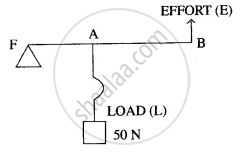Advertisements
Advertisements
Question
The diagram below shows a lever in use.

(i) To which class of lever does it belong?
(ii) If FA = 40 cm, AB = 60 cm, then find the mechanical advantage of the lever.
Solution
(i) Class 2 lever.
(ii) We know,
L × LA = E × EA.
M.A. =`"L"/"E"=("EA")/("LA")`
= `100/40`
= 2.5
APPEARS IN
RELATED QUESTIONS
The diagram below shows a lever in use:

- To which class of levers does it belong?
- Without changing the dimensions of the lever, if the load is shifted towards the fulcrum what happens to the mechanical advantage of the lever?
Draw a diagram of a lever which is always used as a force multiplier. How is the effort arm related to the load arm in such a lever?
Class II levers are designed to have ______.
Fig 3.17 below shows a lever in use.

(a) To which class of lever does it belong?
(b) If FA = 80 cm, AB = 20 cm, find its mechanical advantage.
(c) Calculate the value of E.
Give three examples for leavers of the third order.
Which class of lever found in the human body is being used by a boy when he raises the weight of his body on his toes?
The following belong to which class of lever?
An oar of a boat
The following belong to which class of lever?
A fire tongs
The following belong to which class of lever?
Knife
Shears, used for cutting metals and scissors used for cutting clothes are both examples of levers of the first order. However, whereas the shears always have short blades and long handles, the scissors often have blades much longer than the handles. Explain, why this is so?
